Ox String For Pickleball
Attention: Pickleball Players & Coaches
The Ox String is the retractable, pocket-sized, Patent Pending tool that has been proven to help athletes build skill up to 288 TIMES faster than traditional skills training on it's own!
It can help you:
- Improve vision speed & accuracy to see the ball clearer, track fast balls easier, judge distances more accurately, and hit it with the sweet spot more consistently!
- Stabilize dominance to 1 eye to make accurate hits fast and automatic with BOTH your forehand and backhand.
- Dramatically increase the speed you identify where the ball is going and your ability to REACT FAST and return the ball to the exact spot where your opponents aren't!
And do it all in just minutes without having to spend tons of additional time practicing!
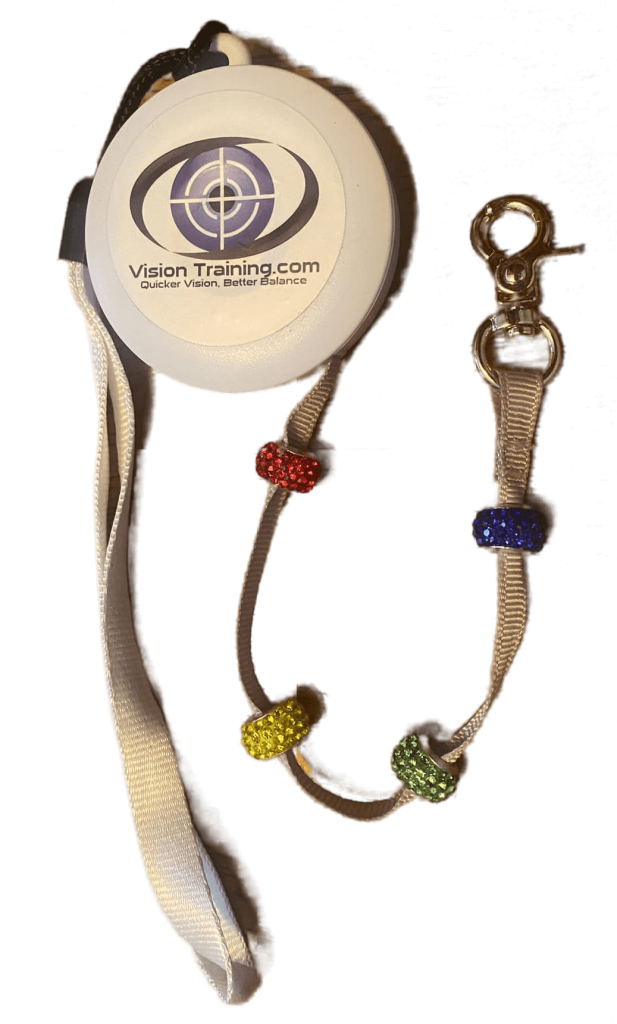
Hit The Corners
When you can judge distances more accurately, you can not only hit the ball easier, but you can hit the sidelines or bury the ball in the corner...making it harder for your opponents to get to AND forcing them to decide whether it's in or out.
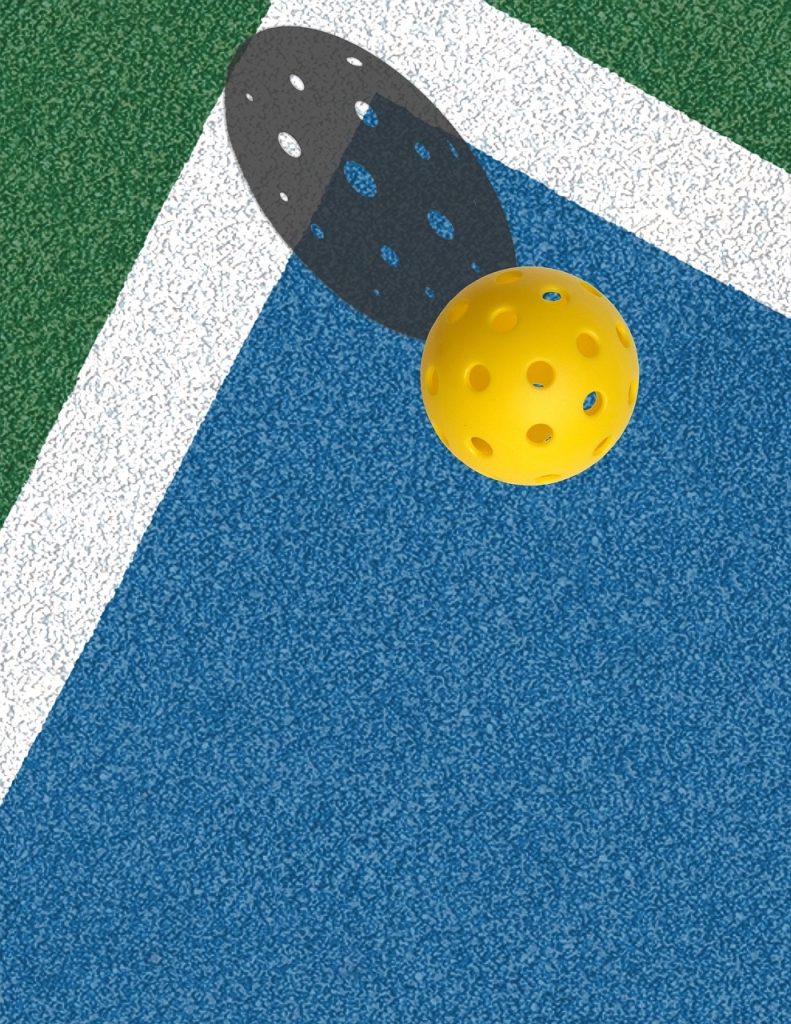
Reduce Eye Strain
A lot of eye strain happens because the eyes aren't working together the way they should.
When we get them working together, late game vision and overall energy levels improve...and players see the impact both on and off the court!
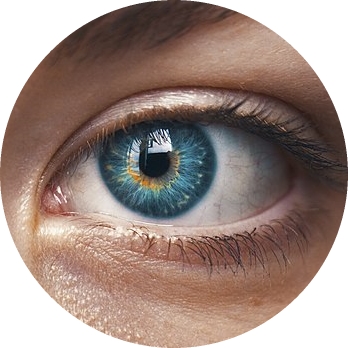
Track The Ball Faster & Hit The Sweet Spot More Often
When we speed up the speed of eye movement and visual processing, it slows the game down and lets us track and react to the fastest balls.
When we combine that speed with improved hand-eye coordination, we can hit the sweet spot more often so the ball goes exactly where we want it to go.
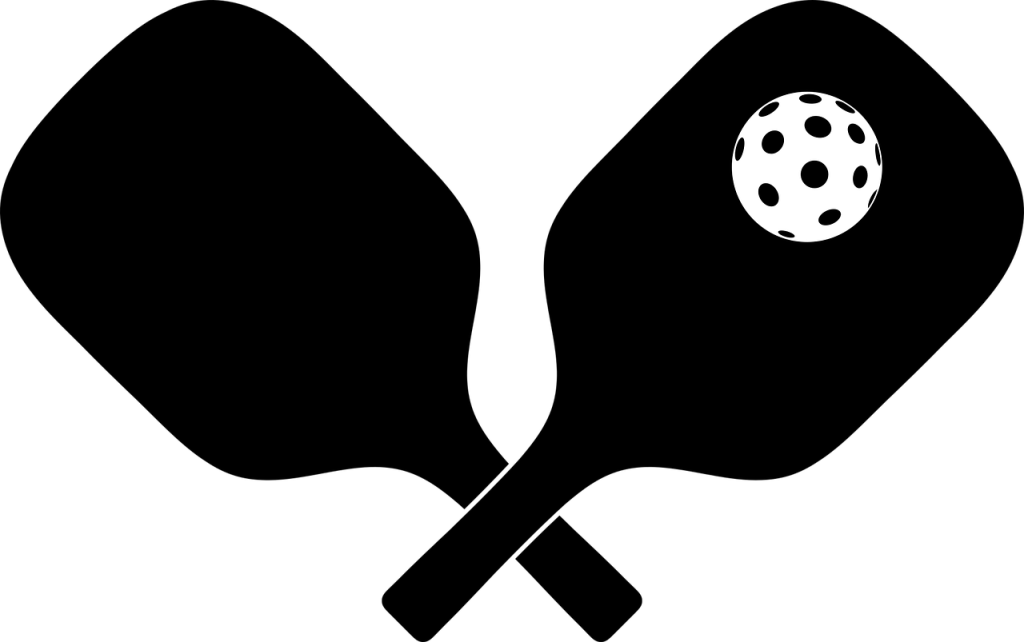
How's This Possible?
I had a strange "ah-ha" moment a couple of years ago.
You see, I'm a neurology based firearms instructor, author, speaker, and consultant. I teach people how to perform skills at a high level under extreme stress when lives depend on performance.
After going through my training, I started hearing back from students about how much better they were playing pickleball! As I dug into it, it made perfect sense.
Most pickleball training focuses on technique and gear. Those are important, but 80% of pickleball is above the neck...mental and visual, and when you've got that dialed in, you can perform better in any and every situation.
The "above-the-neck" stuff is what drives (or limits) your ability to perform up to our capabilities because it's the foundation that all skill and technique is built on.
It's what will let you squeeze the last drop of performance out of the training and gear you've got.
But most paddle ballers struggle with one or more of the following and they act like a parking brake on performance and no training or course has addressed them all, until now...
When pickleball players get this wrong, they oftentimes end up hitting much better on one side of their body than the other. When we get it right, their play gets more balanced and BOTH sides improve.
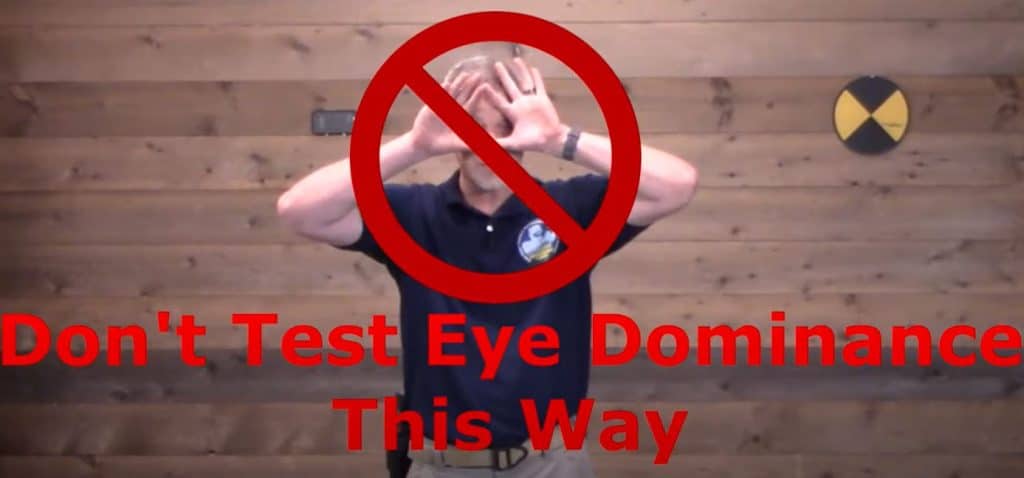
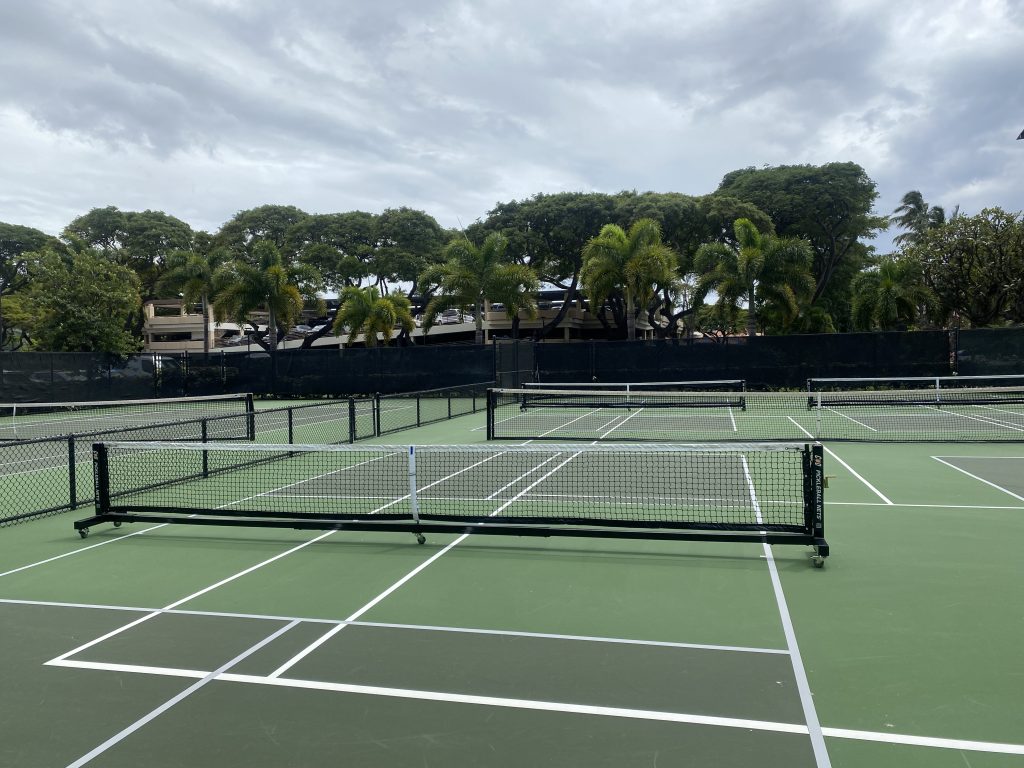
Each of these problems acts like a parking brake on performance. Combine 2-3 of them, and it's super-frustrating. Possibly enough to quit playing.
People chase after the problem by trying to throw time and money at it when the solutions are normally only a few minutes away in their brain...and it's just WAITING to take the brakes off and let you perform.
This training is the difference between performing at your best SOME of the time and taking the brakes off and performing at your best ALL of the time.
This may sound like a lot, but after working with thousands of clients and students, I've distilled the process to help all of these issues down to a few fast, simple sequences of drills that you can do at the home or at the courts.
Just one of these drill sets has been been shown to improve performance up to 288 TIMES faster than traditional training with nationally recognized instructors.
And when you use these drills before you train or compete, you'll learn faster, retain skill longer, and perform better and more consistently under stress.
Unbelievable? Absolutely.
True? Yes...but let me tell you how.
You can either read, watch, or do both.
If you'd rather watch, I've got a video of a presentation that I gave at a national shooting expo to a room of more than 100 shooters where I walk them all through some of the drills I mentioned above. In the video, I'm talking about shooting, but all of the core vision, balance, hand-eye coordination, and stress modulation skills are just as fundamental for pickleball...oftentimes more so.
In the presentation, I had them do assessments, some quick drills, and then re-assess and you can see just how dramatic their improvement was in real time.
You can even do the drills at home and see for yourself.
And will give you a small taste of how I can help you play better, have more fun, and impress your friends at pickleball...
If you want more detail, keep reading.
I mentioned eye dominance earlier.
Right eye dominant and left eye dominant are the easy ones.
11% of the population has Cyclopean or "central" dominance where the brain combines the images from each eye into a hybrid 3rd image that doesn't exist in reality that appears to come from an eye in the middle of the forehead.
Another 10%-20% have "shared dominance" where the image that they try to use for sighting appears to come from the corner of the eye, rather than the middle of the pupil.
That gives us 4 different types of eye dominance.

Anything other than having stable dominance at a single eye is going to cause you to miss the sweet spot on your racket more than necessary and have the ball come off of the paddle at a different angle than you intended.
Since my main focus has been vision training for shooting, I had to come up with ways to help people with vision issues IMMEDIATELY, while 5-10 or more other students were watching and waiting.
I didn't have months or weeks or days to help them...I had to develop ways to help shooters stabilize eye dominance to one eye in just a few minutes.
And what we figured out pretty quickly is that the eye dominance drills that I taught for tactical applications also work incredibly well for pickleball and helped shooters finally start nailing both forehands and backhands.
What about "cross dominance" when your racket hand is on the opposite side as your dominant eye? As long as dominance is stabilized to that eye, it's not a problem...but a lot of problems, including shared dominance, eye alignment, and eye coordination get blamed on cross dominance unfairly and inaccurately.
2. Eye alignment. People understand that eye alignment issues like being cross-eyed or having a lazy eye cause challenges, but because of how the cones of the eye are concentrated in the center, an alignment issue of as small as 1 degree (too small to see) can make a big difference on pickleball performance and cause us to miss towards our non-dominant eye or sometimes even see double. The Ox String is the easiest, most portable tool to help with this.
This can make a huge difference on eye fatigue and end-of-day consistency and performance.
3. Eye coordination. Many people's eyes are in alignment when looking at a stationary target but when we try to track a target, the eyes move at different speeds or one eye moves smoothly and the other "skips" or is "jumpy." To add to the frustration, it's common for eyes to be coordinated in one direction, but not in the other!
This can be the culprit when it's easy to hit balls going from left to right but a challenge to hit balls going from right to left (or vice-versa).
Few pickleballes have ever known how to figure out if they have this issue, let alone how to fix it, but you'll learn how in the training.
4. Reaction time / Vision speed. The more of these issues we have, the harder our brain has to work in order for us to play. As we address them and are able to see quicker, then we're naturally able to react quicker, move quicker, and hit quicker. In the training, you'll learn specific drills you can do to upregulate the brain's visual processing speeds. My story was dramatic and not-typical because of concussions, but these drills allowed me to increase the speed that I could shift focus by 6X!
How's the Ox String Work?
In the basic version of the Ox String drill, shooters hold one end of the Ox String at their nose and either hold the other end with their other hand OR fully extend the Ox String and either attach it to something solid or have a training partner hold it.
Then, they focus on one of the beads.
In the image below, I'm focusing on the green bead.
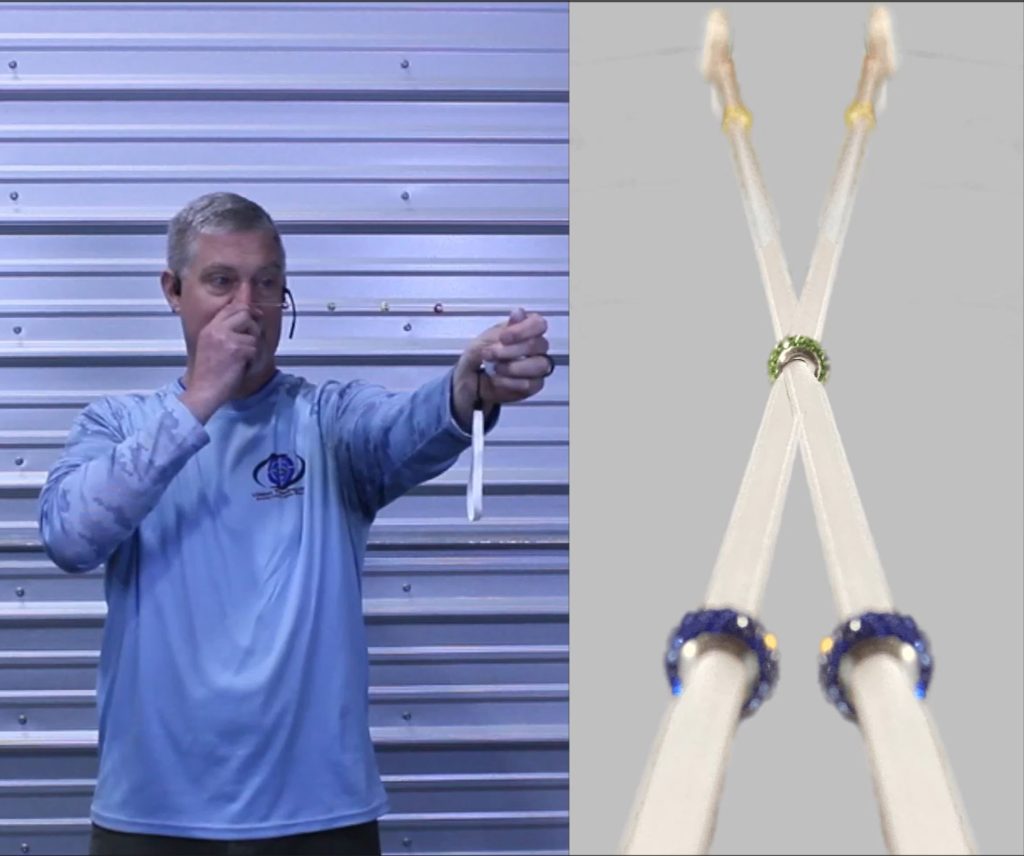
If your eyes are both pointed at the green bead and your brain isn't suppressing (turning down the intensity of) the image from either eye, you'll see an "X" form at the green bead.
But many people don't see an X at the bead...and that's a problem.
If Our Brain Doesn't See The X At The Bead...
In the images below, I'm showing 6 different versions of what people might see if they're visually fixating on the BLUE bead.
The brain might also partially or completely suppress (turn down the intensity of) the image from one eye or the other and make sections of string fade or disappear completely!
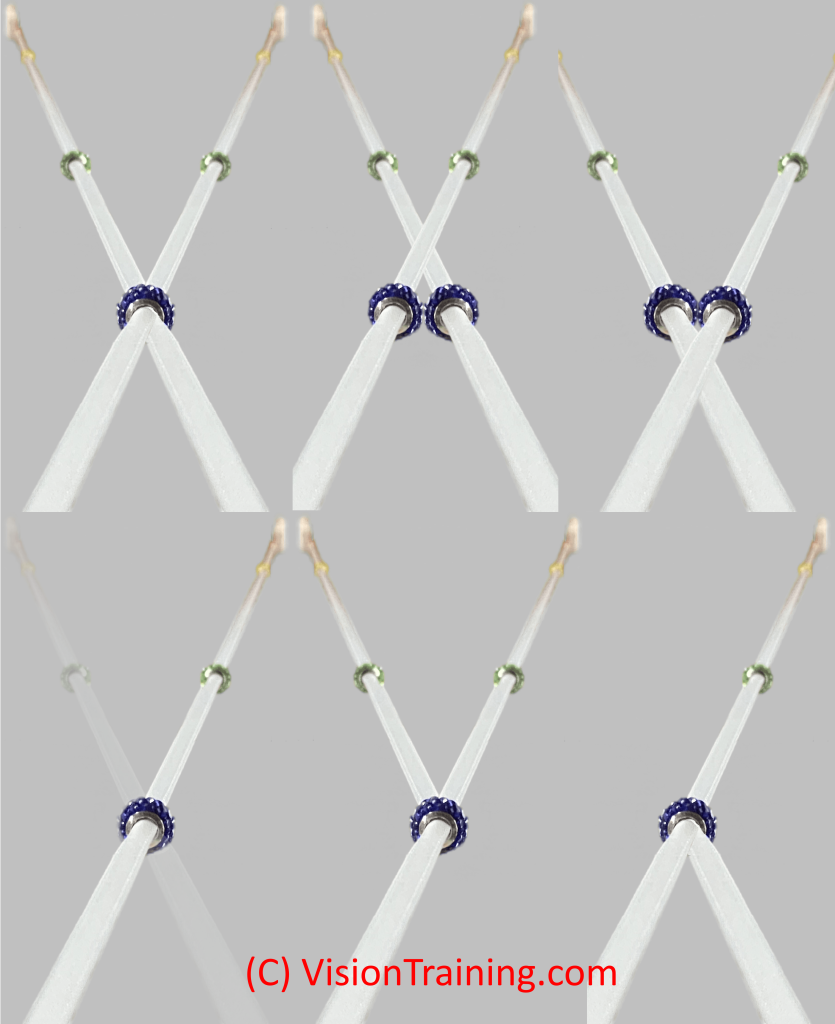
Each of these impact performance in different ways...causing frustrating misses to the right & left, long and short.
And "getting the X" is only the beginning...
Once we get the X with one bead, then we start getting the X at different distances, increasing speed, and doing drills to increase our ability to shift focus quickly in any direction, track targets in all directions clearly, get the eyes working together better while moving, and more.
And the impact goes WAY beyond playing pickleball better...
All of these, except the first one, cause the brain to burn excess oxygen and glucose when we try to play, move, or read and it's like trying to go through life with the parking brake on...we'll probably get where we're going, it'll just take longer and performance will be a little sluggish.
Using the Ox String allows us to quickly identify these issues AND oftentimes dramatically improve performance in just a few minutes.
And I've used it to improve performance with pickleball, shotgun, pistol, and rifle (regardless of the sighting method), martial artists, and athletes involved in golf, basketball, football, baseball, volleyball, soccer, cornhole, billiards, golf, driving, trail running, and any sport or hobby that involves movement.
Even for non-active people, these drills help reduce eye strain when doing screen work, can reduce headaches and neck tension, improve reading speed & enjoyment, help with stair/obstacle navigation and fall prevention...and much more.
This is possible because we've got 20+ areas of the brain that are responsible for visual processing and vision accounts for 70%-80% of our sensory input. When there are unresolved issues with vision, it can have a major impact on every area of our lives, whether we realize it or not.
And the quick & easy drills you can do with the Ox String are some of the highest leverage drills you can do to help with all of these things.
A Knotty Little Problem
With the "Brock" String
You may have seen "beads on a string" before...About a century ago, a Swiss-born optometrist, Dr. Fredrick Brock was struggling with eye alignment issues and did not want to entertain surgery as an option.
He realized, even back then, that when the eyes are not aligned correctly, the brain has to work harder than it should to process the images from the two eyes, to avoid threats, and to avoid tripping and falling more than necessary.
People make the mistake of thinking that the eyes have to be WAY out of alignment for it to matter, but a tiny deviation of even 1 degree (smaller than what most people can see in a mirror) can have a huge impact on everyday life AND performance.
So, he created a vision training tool called the Brock String that is basically a string with colored beads on it that allowed him to correct his own eye alignment issues, and then thousands of patients over the course of his career.
In the decades since, millions of people have been helped by the Brock String...including me.
I've used the Brock String with hundreds of tactical athletes, ball sport athletes, people with reading challenges, and people concerned about reducing their trip & fall risk with fast, dramatic results.
My good friend and creator of the US Navy SEAL Sniper Training Program, Chris Sajnog, had such good success with the Brock String that he called it "Front Sight String."
But the Brock String has always had a knotty problem.
It works best when it's permanently tied to something...and that's not good for sports.
As soon as you try to put it in your pocket or a bag, the old-school Brock String has a magical ability to become a jumbled mess of knots. And then you have to waste 5-10 minutes de-tangling the string just to do a minute or two of drills.
I knew there had to be a better way...
So, over the last decade, I've used or created 50+ alternatives to the Brock String to solve this knotty problem...but the Ox String is the only one that's so different and so improved that it's worthy of a patent.
The most dramatic feature of the Ox String is that it's retractable and portable. It fits in a pocket or bag so that you can always have it near and it will never get tangled.
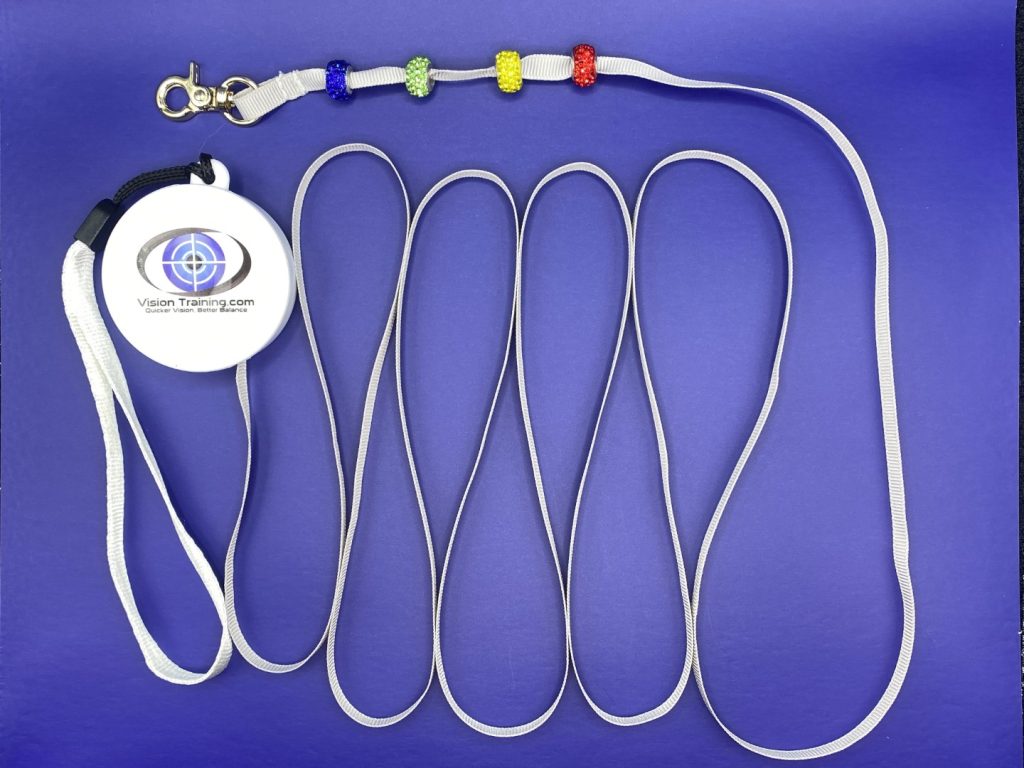
The beads are quite different than what has ever been used on a Brock String before...the diamond-like facets, the specific shades of colors used, and even how the silver interior and primary colored exterior subconsciously interact with the brain to automatically pull the eyes into alignment all make the Ox String dramatically more effective than an old-school Brock String.
The Brock String is great...and you can make your own by simply tying a few knots in a shoelace, but the Ox String will allow you to do much, much more.
Until now, the Ox String has only been available for people taking my live Vision Training for Instructors course ($700) or the See Quicker Shoot Quicker 2.0 training ($97), but today, you can get your own Ox String for only $37!
What Kind Of Drills Will I Get?
Great question.
It depends on which package you get. In the case of "See Quicker Shoot Quicker," it includes a lot of the drills that I used to recover from my concussions, but it's delivered in a "shooting" context. That being said, I've seen the drills in that training create a bigger difference for pickleball players because of how much movement there is in pickleball.
You've got 3 options:
| Drills Included | Neuro-Sync Protocol | Neuro-Sync + Ox String | See Quicker Shoot Quicker 2.0 |
|---|---|---|---|
| Price | $17 | $37 | $97 |
| Patent Pending Ox String | ✕ | ✓ | ✓ |
| Build-Your-Own Vision String Instructions | ✓ | ✓ | ✓ |
| Front Sight Ox String Drills | ✓ | ✓ | ✓ |
| Stabilize Eye Dominance Ox String Drills | ✓ | ✓ | ✓ |
| Visual Suppression Ox String Drills | ✓ | ✓ | ✓ |
| Both Eyes Open Ox String Drills | ✓ | ✓ | ✓ |
| Target Transition Ox String Drills | ✓ | ✓ | ✓ |
| Moving Target Ox String Drills | ✓ | ✓ | ✓ |
| Level 1 Stress/Amygdala Modulation Drills | ✓ | ✓ | ✓ |
| Ox String Drills From Red Dot Mastery Book | ✓ | ✓ | ✓ |
| ADVANCED OX STRING DRILLS | |||
| Dynamic (shooting on the move) Ox String Drills | ✕ | ✕ | ✓ |
| Inhibition Drills with Ox String | ✕ | ✕ | ✓ |
| Hand-eye coordination Ox String Drills | ✕ | ✕ | ✓ |
| Advanced Ox String Sensory Integration | ✕ | ✕ | ✓ |
| Advanced Ox String Trip Avoidance Drills | ✕ | ✕ | ✓ |
| NON-OX STRING VISION AND SENSORY INTEGRATION DRILLS | |||
| Advanced Vision & Breathing for Stress Modulation and Amygdala Deactivation | ✕ | ✕ | ✓ |
| "Flinch Fixer" drills | ✕ | ✕ | ✓ |
| Muscle Tension Melter vision drills | ✕ | ✕ | ✓ |
| Enhanced "natural point of aim" drills | ✕ | ✕ | ✓ |
| Concussion/TBI/Long Covid Drills | ✕ | ✕ | ✓ |
| Peripheral Awareness Drills | ✕ | ✕ | ✓ |
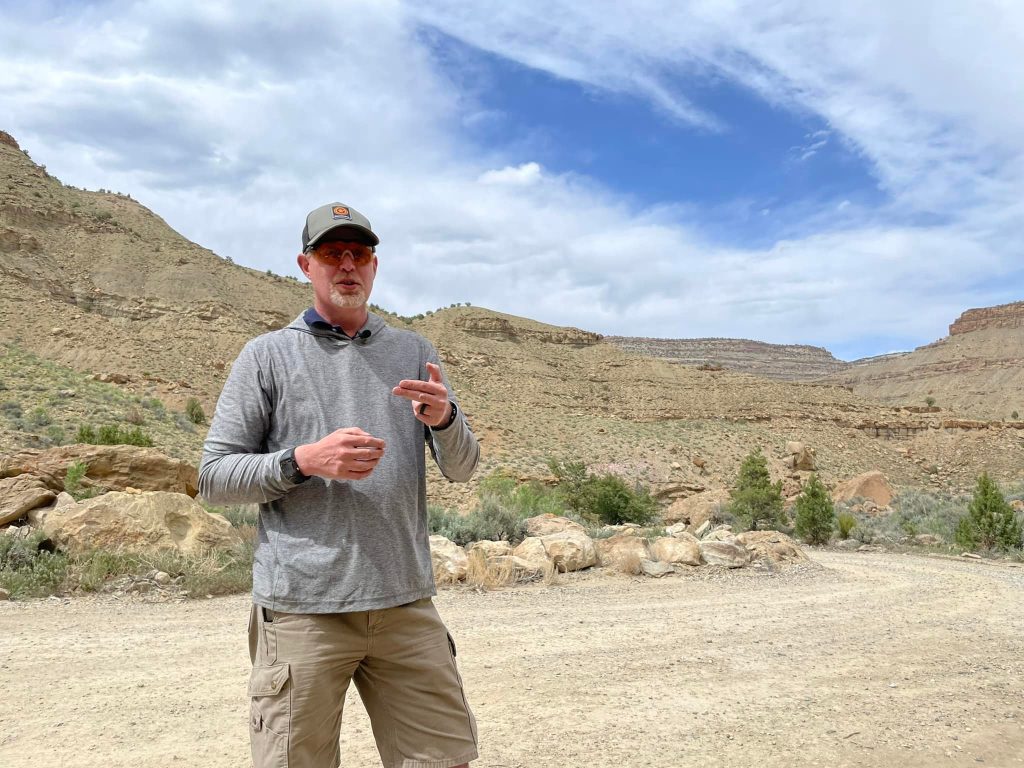
I'm Mike "Ox" Ochsner. I'm one of a handfull of neurology based firearms instructors in the world.
I wasn't always a neurology professional. It was kind of forced on me.
In my mid-late 30s, the consequences of 15+ concussions where I lost time caught up with me. None of my concussions were from heroic deeds. I've had more than my share of hard impacts with rocks, cement, trees, fists, and heads. And more than a lifetime of being next to people shooting .50 caliber rifles with muzzle brakes.
As a result, I had vertigo most nights for a few years, my eyes stopped tracking correctly, I had constant headaches, I went from being very athletic to falling often (and getting more concussions), reading wasn't fun anymore, my hand-eye coordination stopped working, and I had constant random pains on the left side of my body.
Life sucked and it was hard. I wasted a ton of energy "seeing," not falling, and not running into things.
I had to make a choice of whether this was my new "normal" or if I had another option.
Neurology, and specifically vision training, helped me get my life back...in less than an hour with a neurology trainer.
On a hunch, I started using some of the drills that helped me with shooters I was working with, and saw explosive results.
I was hooked.
I dove deep down the neurology rabbit hole...training with Next Level Neuro, Z-Health, Wharton Neurology, and more. Hundreds of hours of neurology continuing education...including more than 100 hours of live training this year alone!
Neurology and vision training changed my life. It took at least 10 years off the clock and allowed me to become a master level shooter with a subcompact.
In the process, I wrote a book on neurology based gun training that's been called the best firearms training book in existence and used by elite military, law enforcement, and civilian instructors and shooters. More recently, I was the co-author of the best selling book, Red Dot Mastery. My presentations at firearms instructor and neurology conferences have been called the best in 20 years, and I've had the opportunity to help thousands of shooters use neurology and vision training to unlock performance that they didn't think was possible for them.
And I'd like to do the same for you with this training.
Frequently Asked Questions
I've been told I don't have a dominant eye...can this help me?
People who THINK that they don't have a dominant eye are oftentimes the ones who the Ox String helps the most.
The fact is that the brain prefers one eye over the other for sighting and threat avoidance and it's the eye who's image gets processed fastest...not necessarily the clearest eye or the eye we'd like it to be. In some people, eye dominance is determined by one optic nerve being a single neuron shorter and the signal getting processed 6, 14, or 15ms faster, depending on the study.
Eye dominance is contextual and can change based on which direction we're looking/pointing and even something as simple as whether our nose/glasses are blocking our dominant eye from seeing the ball or target.
To top it off, most eye dominance testing is only designed to show people whether they are right or left eye dominant. The brain is more complex than that and there are actually 4 types of dominance that we want to test for. The Ox String will help stabilize dominance to the right or left eye to make fast+accurate play much, much easier so that we not only play better early on, but have more gas in the tank at the end of matches.
I already have a Brock String...will this help me?
YES! You'll find that the portable nature of the Ox String AND the greatly expanded drills will let you do things that few knew were possible with the old-school Brock String.
I have Monovision...can this help me?
Monovision is where one eye sees up close better and the other eye sees far away better. It can happen naturally, because of injury, because of contacts, or because of surgery.
Monovision promises the best of both worlds at a tremendous cost. In fact, monovision causes distortions in perception extreme enough that the FAA has a restriction on monovision for pilots.
If you have monovision contacts, I would reccomend taking them out to train on the Ox String.
If you have monovision because of an injury or surgery, then there will be benefits to getting the eyes to work together, but the close eye's perception of the string/bead will always be much clearer and crisper than the far eye's perception and you may want to work with the Ox String at further distances rather than up close.
How Do I Go Through Your Live Vision Training?
I run a live online Vision Training for Instructors class a few times a year. You get immediate access to the recordings of past classes, as well as the ability to re-take the class multiple times. For details, click the "Questions" link below.
How Do I Schedule You To Consult For Our Agency/Unit/Company and/or Speak At Our Conference?
Click the "Questions" link below and we'll get you taken care of.
I only have 1 eye...how can this help me?
My father in law lost an eye to cancer and my best man and friend for 30+ years lost his eye in a skiing accident when we were seniors in high school and I work with one-eyed shooters on a regular basis.
Some aspects of vision aren't an issue for one-eyed shooters, like coordination between the eyes, fusion of the images, and dominance.
The base training and Ox String on it's own won't be a great solution for one-eyed shooters, but there are several aspects of vision that we cover in the See Quicker Shoot Quicker 2.0 training that can have a dramatic impact for one-eyed-athletes.
Some of them are:
-Sensory integration (getting your eye, inner ears, and body awareness on the same page about how you're moving and which direction is straight ahead.)
-How to use the eyes to inhibit or stop choking under stress.
-How to improve the quality of eye movements so that you can track balls faster and more accurately
-How to improve your ability to do fast+accurate "shifts" of the eye so you can dink without hitting the net and bury the ball in the corners without going out.
-How eye movements impact residual muscle tension that can create stiffness and soreness
-Drills to improve your instinctive aiming ability
-How to expand and improve peripheral awareness and peripheral vision...which oftentimes helps with tight/sore neck and back muscles.
How's the DIY "Build-Your-Own" Option Work?
Over the years, I've created 50+ different versions of the original Brock vision training string, and improvised solutions when nothing else is available. None of them are as fast, easy, or effective as the Retractable Ox String, but they do work and I still use them in a pinch. You're going to want these even if you get an Ox String in case you find that you need to do the drills and forgot your Ox String or don't have it with you.
In the training, you'll learn how to make your own vision training string out of whatever items you happen to have in your environment.
Once you experience the impact of the drills, you'll understand why it's so important to have a way to do the drills...even if you don't have your Ox String yet or don't have it with you.
Questions?
Click HERE And Ask Away...

You also agree to take responsibility for your actions and hold this site, the author, and anyone associated with the site or the author harmless for the use or misuse of the information that you find through the course of visiting this site.
Government Contracting Info: CAGE: 894B7 D-U-N-S: 116986122
Copyright © UrbSurv LLC 2025
Read The Blog Contact Us Privacy Policy Terms of Service
